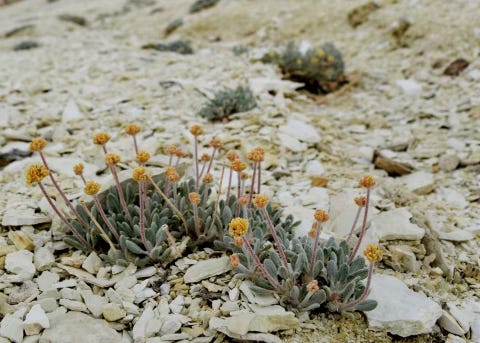This is one of those conflicts that fill some business proponents and rightwing folks with eco-freude, the happiness they experience when environmentalists and conservationists appear to be at each others’ throats.
The conflict centers on a proposed lithium mine in Nevada. If the project goes through, the footprint of the mining operation will destroy habitat of the Tiehm’s buckwheat (Eriogonum tiehmii), a very rare perennial whose habitat extends through only of 21 acres of the Nevada desert. As originally planned, 80 to 90 percent of the buckwheat’s habitat would have been wiped out. Although the planned footprint of the mine has been reduced, its construction could still lead to the extinction of the species.

Tiehm’s buckwheat is small and low growing, with bluish gray leaves. Creamy/yellowy flowers sit atop six-inch-high stalks. The flowers can turn red with age. And, yes, this species is a member of the Buckwheat plant family.
Lithium, of course, is the element that is enabling, at least in part, the green transition away from fossil fuels. It’s in the high-powered batteries that provide the juice for electric cars and e-bikes. Promoting the mine, the Biden Administration says the project, “represents another step by the Biden-Harris administration to support the responsible, domestic development of critical minerals to power the clean energy economy.” The mine owner also uses this green street cred in promoting the project.
What’s happened so far
An Australian company, Global Geoscience, announced in 2018 that it was planning a lithium and boron mine in an area of southwest Nevada between Reno and Las Vegas.1 (In November 2018, Global Geoscience changed its name to ioneer.) The site of the proposed mine, the Rhyolite Ridge, sits over the largest lithium-boron deposit in North America. Looking at the company’s promo video from the time, I don’t know if they knew of the existence of the buckwheat at the site.
In October 2019, the Center For Biological Diversity (CBD) petitioned the U.S. Fish & Wildlife Service (FWS) to list the Tiehm’s buckwheat as endangered under the Endangered Species Act (ESA). They also petitioned the state of Nevada to protect the plant as endangered.
September of 2020 saw a bizarre turn of events, when 17,000 of the buckwheat plants were dug up or otherwise destroyed. The destruction reduced the population of the Tiehm’s buckwheat by about 40 percent. At the time, Patrick Donnelly, the CBD’s Great Basin director had this to say:
This appears to have been a premeditated, somewhat organized, large-scale operation aimed at wiping out one of the rarest plants on Earth, one that was already in the pipeline for protection. It’s despicable and heartless.
Indeed, the destruction seems quite suspicious; however, lab technicians from the University of Nevada Reno visited the site on September 8, 2020. They reported that the roots of the buckwheat looked as though they had been gnawed, and they did not see any tracks that could have been left by humans or large animals. The FWS concluded that the destruction was the result of animals consuming the plants, although Donnelly disagrees:
We went out there over the weekend, and we discovered dramatic impacts to the buckwheat. Some were destroyed, some were half destroyed, and there were many holes in the ground where buckwheat were removed. So we saw evidence of humans doing this including recent footprints, developing social trails, and scrapes consistent with some sort of trowel being used to dig up these buckwheat.
In September 2020, after the destruction, the CBD sued the FWS and the Bureau of Land Management for emergency ESA protection. The service granted the buckwheat ESA protection in December 2022. The biggest reason the agency cited for granting the status was the proposed mining operation. Within days, however, the Bureau of Land Management (BLM) announced it was commencing the environmental review for the lithium mine.
For their part, ioneer says the company “is committed to Tiehm’s buckwheat conservation while sustainably developing our Rhyolite Ridge Project.” The company claims it has spent $1.5 million on voluntary conservation efforts, including fencing, signage, and surveying the buckwheat population. They built a greenhouse in 2023 dedicated to propagating the species. The revised plan for the mine reduces damage to the habitat, destroying 22 percent of the Tiehm’s buckwheat’s range.
The CBD nonetheless criticizes ioneer, saying the company already caused damage to the buckwheat early last year, when it put in a staging area for drilling operations.
In the latest development, earlier this month, the BLM delayed release of the draft environmental impact statement for the mine; yet it has also been criticized for the manner in which it has expedited the environmental review process for the project.
Although the Rhyolite Ridge is a rich deposit, there are other places where lithium can be got out of the ground. And, as the Supreme Court ruled in the seventies, in Tennessee Valley Auth. v. Hill, the Endangered Species Act was passed for precisely this reason: to protect the rare, obscure, and out-of-the-way species. Do you have thoughts on the proposed mine? Please click the “Leave a comment button” below. I’m eager to hear what you have to say on this subject.
X (You can find me on that thing formerly known as Twitter.)
'Global Geoscience Announces Successful Completion of Phase 1 of Rhyolite Ridge PFS Demonstrating a Clear Path Forward' (2018) GlobeNewswire, 23 May, available: https://link-gale-com.sdpl.idm.oclc.org/apps/doc/A539898957/STND?u=sddp_main&sid=bookmark-STND&xid=8316d97e [accessed 24 Apr 2024].






This was an interesting read and well researched read that brings up a question I have been struggling with a for a while. Are some "green" initiatives worth it? Personally I believe that this mine should not continue if it risks the extinction of the buckwheat even if it's for batteries for electrified bikes and cars. While they are, on the surface, better than gas powered cars when it comes to green house gas emissions, it's also important to consider the impact of electrified vehicles in other areas. For example, the upholding of car centric infrastructure, pollution from mining, and more things like this, that result in direct environmental destruction. I think right now we are in a world saturated with greenwashing and should continue to look at all actions with a critical environmental and human health centric eye.
Paul, you and your readers may be interested in knowing about the lithium mine at Thacker Pass, NV. Mining is a filthy enterprise, and this operation tramples the rights and culture of tribal communities in the area, and requires extreme amounts of water. Water requirements come to 30 billion gallons a year, and it turns out my estimate for the life of the mine, 1.38 trillion gallons, was considerably low. This in a region of extreme historic drought. There is nothing green about lithium. https://geoffreydeihl.substack.com/p/showdown-at-thacker-pass